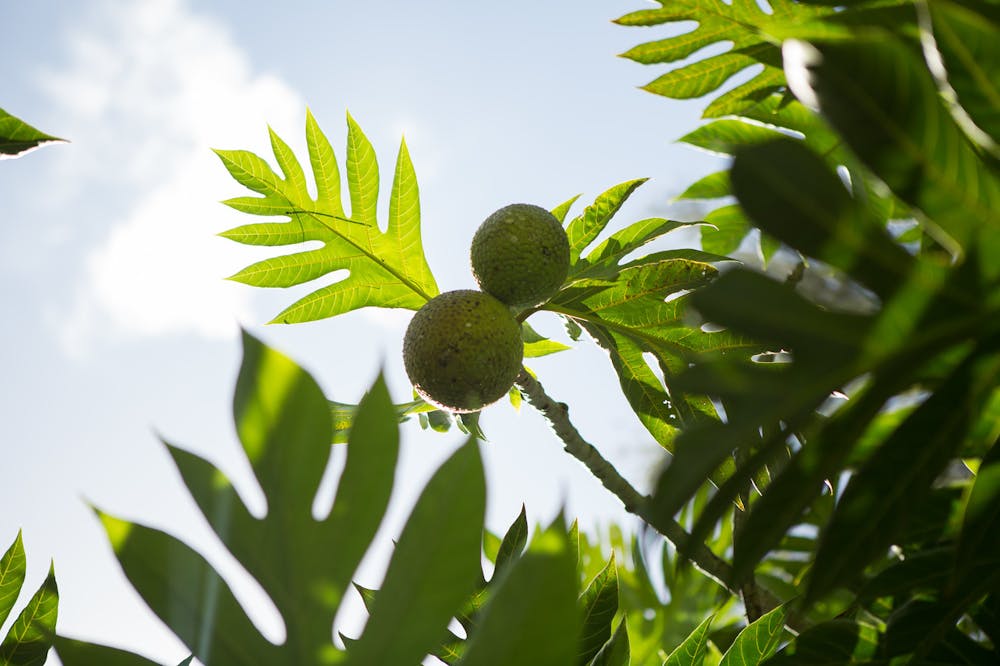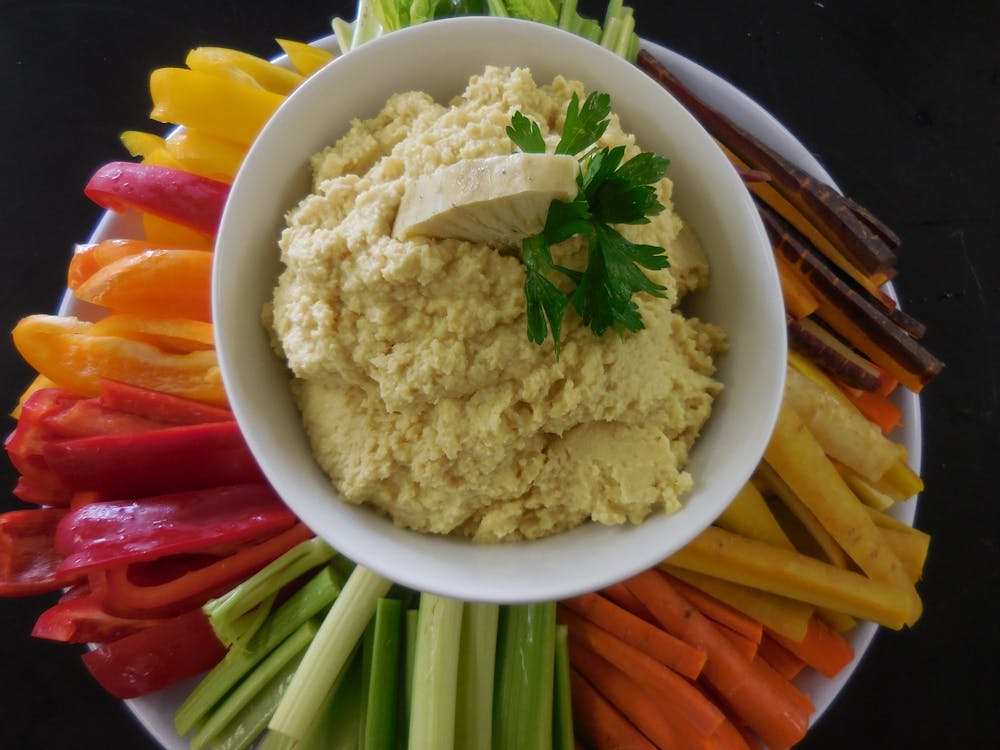The Breadfruit Institute

Approximately 1,500 years ago, braving the open ocean in their double-hulled voyaging canoes and navigating by the stars, the first humans migrated to Hawaii from the Marquesas Islands, Tahiti, and other island groups. The migration happened in waves, over centuries, and the settlers brought with them more than two dozen plant species essential to their survival and the perpetuation of their cultures. These staple crops are known here in Hawaii as the “canoe plants” and they include species such as banana, coconut, sugar cane, sweet potato, bamboo, turmeric, and ginger.
In this blog post, we’re highlighting one very special canoe plant: BREADFRUIT. Also known here in Hawaii as ulu, breadfruit is increasingly becoming recognized for its potential to ease global hunger in the midst of climate change.
We’ll share some general info about breadfruit and the extremely important work of The Breadfruit Institute here on Kauai. We’ll also share a Breadfruit Hummus recipe, in the hopes that you’re inspired to try this magical superfood for yourself.

Some facts about breadfruit:
- Breadfruit tastes awesome and can be prepared and eaten at all stages of development. There are endless ways to prepare breadfruit: steamed, boiled, fried, baked, or cooked in traditional ways such as in a fire. Once it’s cooked, it can be thrown in all sorts of dishes such as casseroles, fritters, croquettes, pancakes, breads, curries, stews, chowders, dips, and salads. It’s kind of like a plantain or a potato—starchy and can be processed and prepared in any and all ways.
- It’s a fantastic source of complex carbohydrates (yet gluten-free and low-glycemic), fiber, potassium, calcium, iron, magnesium, phosphorus, manganese, zinc, B vitamins, niacin, thiamine, and Vitamin C. Importantly, its protein is complete, providing all of the essential amino acids necessary for human health.
- Breadfruit trees are considered one of the highest-yielding food plants on the planet– one tree can produce hundreds of fruits per year and sustain a family of four for decades.
- Breadfruit trees are beautiful and low maintenance. Once established, they require little attention or care, thrive under a wide range of ecological conditions, and produce an abundance of food with minimal input of labor or materials such as fertilizers.
- Breadfruit trees provide food security and contribute to diversified regenerative agriculture and agroforestry, improved soil conditions and watersheds, and valuable environmental benefits including reduction of CO2. They also give shelter and food to important plant pollinators and seed dispersers such as honeybees, birds, and fruit bats. Simply put, the world needs more breadfruit trees! Especially when you consider the fact that eighty percent of the world’s hungry people live in the tropics, where breadfruit thrives.
Unfortunately, and for a host of reasons including colonization and globalization, the production and consumption of breadfruit has decreased over the last few generations. The neat thing is that breadfruit is making a global comeback, and Kauai is playing an important role in that comeback!
Yes, Kauai is home to The Breadfruit Institute, a National Tropical Botanical Garden program, established in 2003, that’s actively responding to global food insecurity by expanding plantings of breadfruit across the world.
Dr. Diane Ragone, the director of the Institute, has been studying breadfruit for thirty years. She’s traveled to more than fifty islands in Micronesia, Polynesia, and Melanesia, collected more than 150 indigenous breadfruit varieties, and brought them back to Kauai to be conserved and studied.
Elite varieties selected for food security and regenerative agriculture are propagated here on island and sent all over the tropics to be planted– providing food, shade, and economic opportunity.
If you’re interested in supporting this crucial work, you can become a volunteer at the Regenerative Organic Breadfruit Agroforest (ROBA) here on Kauai’s south shore, or you can donate directly to the program.
 Cooking With Breadfruit
Cooking With Breadfruit
But wait, if breadfruit is so wonderful, then why are we barely eating it?
Let’s face it—the global food system has turned us into spoiled brats that have come to rely on foods that are pretrimmed, prewashed, preseasoned, PREPARED already—to one extent or another. Dealing with a whole entire breadfruit can be intimidating because as we mentioned before, the practice of cooking with breadfruit kind of got lost for a few generations.
When is it ripe? Why is it sticky? Do you eat the whole thing? What do you DO with it?
Let’s figure these mysteries out and start taking proper advantage of this incredibly nutritive, sustainable, delicious resource that’s literally growing in our backyards
We recently got our hands on some ripe breadfruit (by volunteering with ROBA), made a delicious Breadfruit Hummus, and guess what, it wasn’t even that hard! The trick was boiling the breadfruit first.

Breadfruit Hummus
1 mature breadfruit (boiled and chopped)
½ cup water
2 cloves garlic, chopped
4 tablespoons lemon juice
2 tablespoons tahini
1 teaspoon salt
black pepper to taste
4 tablespoons olive oil
1. Boil the entire breadfruit for 40 minutes. Just throw the whole thing in there and set your timer for 40 minutes. The breadfruit will float so give it a spin now and then, so it cooks and softens evenly.
- Let the breadfruit cool, ideally for a couple hours. Either way, once it’s cool enough to handle, you can now easily cut the breadfruit in half, cut the rind off, and discard the inner core. At this point, you’re just working with the moist pulp. Chop it up into little chunks.
- Put the chopped breadfruit and all the other ingredients into a food processor or a blender and blend until creamy. If it’s too thick, add more water. Depending on the size of your breadfruit and depending on your taste—you’ll likely need to adjust the amounts of water, lemon juice, tahini, olive oil. It’s not rocket science, it’s just hummus—you can do it.
- Transfer the hummus into a serving bowl, drizzle it with olive oil and sprinkle with pepper or maybe paprika for color. Maybe garnish it with reserved breadfruit chunks.
And that’s it!*
This would be a fun one to take to a potluck and have your friends guess the main ingredient. People will be delighted when you reveal that it’s breadfruit! It seems like we all want to eat more breadfruit, a lot of us are just kind of clueless and lazy about it. Luckily, we have the power to change that!
*The pot and lid you use to boil the breadfruit will likely feel sticky afterwards, from the breadfruit’s milky sap. Pro tip—oil takes it off. Just wipe down the pot with any inexpensive cooking oil you have on hand and then wash with soap and hot water as usual.
We generally send newsletters about once a month
